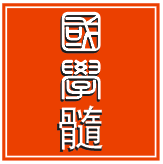 Promoting Traditional Culture, Inheriting the LifebloodContinuing the teachings of the sages, opening peace for all generations
Promoting Traditional Culture, Inheriting the LifebloodContinuing the teachings of the sages, opening peace for all generations
The Qi Huang School of Traditional Chinese Medicine holds a crucial and significant position in traditional culture, being an inseparable part of it. Throughout the long river of history, it has condensed the wisdom of the Chinese people, making significant contributions over five thousand years, safeguarding the historical process of various eras, resisting and overcoming disasters, allowing the Chinese nation to thrive to this day. In this long historical flow, a wealth of medical civilization has accumulated and settled, becoming a brilliant pearl. Sharing the Qi Huang School of Traditional Chinese Medicine daily aims to promote its inheritance and development, better benefiting humanity.

1. Shengzi (Shengzi Point) for Chronic Back Pain, Immediate Effect, No Other Acupuncture Points Can Compare
Location: One inch below the tiger’s mouth on the palm, between the metacarpal bones of the thumb and index finger, connected to the Daba (Dabai) point on the back of the hand.Anatomy: Contains the radial nerve, radial artery, and branches of the lung nerve.Needling: With the palm facing up, the point is located one inch below the space between the metacarpal bones of the thumb and index finger. It can connect with the Daba point.Meridian: Enters the Lung Meridian.Point Characteristics: Dispels wind and releases the exterior, clears and drains lung qi.Indications: Pneumonia, lung cancer, emphysema, colds, cough, asthma, palpitations, fever reduction, laryngitis, back pain, chest pain, knee pain.Needling Technique: Insert straight one to two inches. For pediatric conditions, using a three-edged needle to draw blood is particularly effective.Needle Sensation: Sensation of soreness and distension.Note: Shengzi and Shengxian points are close to the traditional fourteen meridian Lung Meridian, also entering the Lung Meridian, thus can treat lung-related diseases like the Yiji point.
2. Shen Guan (Kidney Gate) Point for Frequent Urination
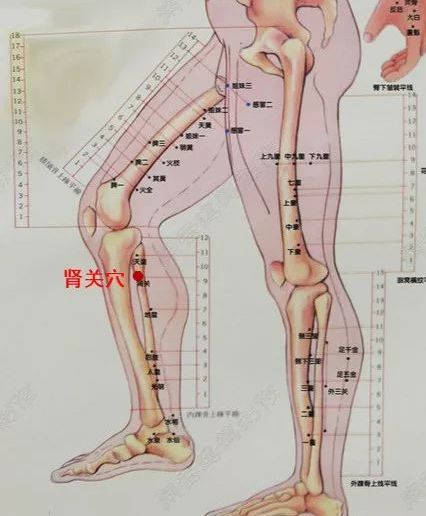
Location: Shen Guan point is located one and a half inches below the Tian Huang point.
Indications: Excessive stomach acid, regurgitation, strabismus, astigmatism, anemia, epilepsy, neurosis, brow pain, nasal bone pain, dizziness.
Needling Technique: Five to one inch. Supplement the kidney two inches deep. Treat excessive stomach acid and regurgitation with the Tian Huang point as a paired needle.
3. Mu (Wood) Point for Goose Foot Disease
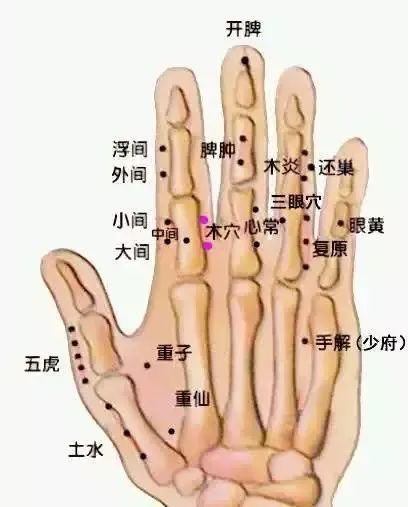
Mu Er (Wood Two) Point
Location: Three-tenths of an inch from the center of the first phalanx of the index finger on the palm side. This is the inner three-tenths of the middle point.
Anatomy: Contains the proper palmar digital nerve and liver nerve.
Needling: With the palm facing up, the point is located three-tenths of an inch from the center of the first phalanx of the index finger (the middle point).
Meridian: Enters the Liver Meridian.
Point Characteristics: Soothes the liver, regulates qi, invigorates blood, and dispels wind.
Indications: Irritability, excessive work, shoulder tightness, pain under the right rib, neck stiffness, high cholesterol, stomach distension and pain.
Needling Technique: Five-tenths needle, straight insertion of two to four tenths.
Needle Sensation: Localized soreness and distension.
Application: Using both hands for needling yields better results.
Note:
(1) In Dong Gong’s writings, the Mu point has a limited range of indications, while Master Hu expanded its range. Lai Zhu in his book referred to the Mu point as the cold point, stating that it is effective for tearing, sweating, stopping sweating, and colds. He claimed that the Mu point can stop cold-induced runny nose in a moment. However, the author believes that to treat cold-induced runny nose, it is better to combine the Mu point with the Sancha San point, Ling Gu, Daba, and add the foot cold point for better results.
(2) The Mu point corresponds to the liver area in the human organ holographic projection, hence its name. Therefore, needling this point is particularly effective for treating pain under the right rib.
Mu Yi (Wood One) Point
Location: Two and a half tenths of an inch below the center of the first phalanx of the index finger on the palm side.
Anatomy: Contains the proper palmar digital nerve and liver nerve.
Needling: With the palm facing up, the point is located two and a half tenths of an inch below the Mu Er point.
Meridian: Enters the Liver, Stomach, and Lung Meridians.
Point Characteristics: Clears liver and gallbladder heat, opens up and unblocks the orifices.
Indications: Bitter mouth, tinnitus, excessive liver fire, irritability, shoulder pain, pain under the right rib, neck pain, high cholesterol, stomach distension and pain.
Needling Technique: Five-tenths needle, straight insertion of two to four tenths.
Needle Sensation: Localized soreness and distension.
Application: Same as Mu Yi point.
Note:
(1) The depth of needling varies according to the meridian being accessed. The Mu Yi, Mu Er, and Mu San points are listed by Master Hu. In Dong Gong’s book, there are two illustrations of Mu points, but only one Mu point is mentioned in the text. These three points can be needled with a five-tenths needle, shallowly inserted one-tenth into the Lung Meridian, and deeply inserted two to four tenths into the Liver and Stomach Meridians. This is a unique feature of Dong’s extraordinary points, and the depth of needling should be particularly noted.
(2) There are three Mu points, and needling all three together can be effective for pain under the right rib. It is also effective for dry mouth and excessive heat.
Mu San Point
Location: Two and a half tenths of an inch above the center of the first phalanx of the index finger on the palm side.
Anatomy: Contains the proper palmar digital nerve and liver nerve.
Needling: With the palm facing up, the point is located two and a half tenths of an inch above the Mu Er point.
Meridian: Enters the Liver, Stomach, and Lung Meridians.
Point Characteristics: Clears liver and gallbladder heat, opens up and unblocks the orifices.
Indications: Bitter mouth, tinnitus, excessive liver fire, irritability, shoulder pain, pain under the right rib, neck pain, high cholesterol, stomach distension and pain.
Needling Technique: Five-tenths needle, straight insertion of two to four tenths.
Needle Sensation: Localized soreness and distension.
Application: The Mu Yi, Mu Er, and Mu San points can be used clinically, and any one or two points can be selected for needling. Using a three-edged needle to draw blood is particularly effective for treating gastrointestinal distension and severe rib pain. Using both hands for needling is not contraindicated.
Note: Lai Zhu’s experience with the Mu point indicates that it can treat easy tearing and dryness of the eyes. Additionally, the Mu point can stop external wind pathogens from causing skin itching, as it enters the Liver Meridian, which connects to the eyes. Therefore, as Lai Zhu stated, it can treat the above symptoms. The author believes that if the Mu point is combined with Dong’s extraordinary point, the San Huang point, the effect will be even better.
4. Gynecological Points for Infertility
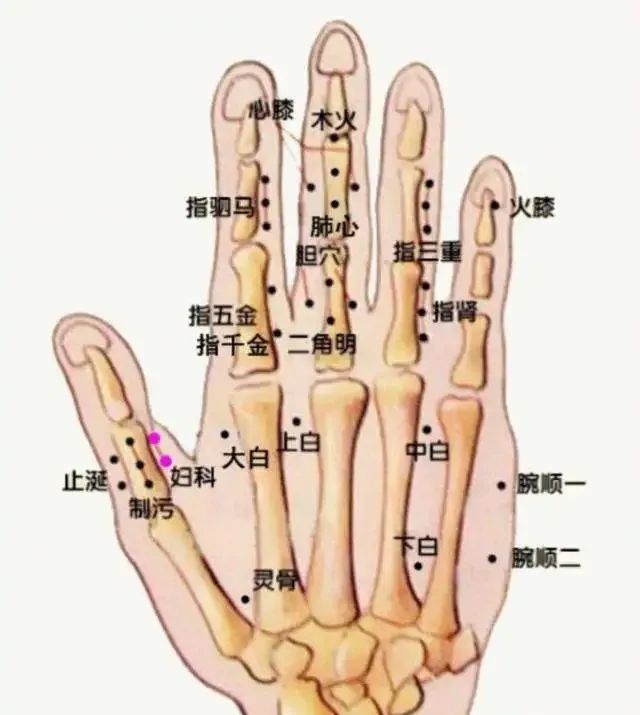
Gynecological Five Points
Location: On the back of the hand, on the outer side of the first phalanx of the thumb, one point every two tenths from the transverse crease of the palm, totaling five points.
Anatomy: Contains the proper palmar digital nerve superficial branches, uterine nerve, and six fu organs nerves.
Needling: On the back of the hand, at the outer side of the first phalanx of the thumb, two and a half tenths from the center, one point every two tenths up to the second phalanx transverse crease, totaling five points.
Meridian: Enters the Ren and Du Meridians.
Point Characteristics: Regulates the Ren and Du Meridians, facilitates the lower jiao.
Indications: Uterine tumors, uterine cancer, uterine inflammation, ovarian inflammation, infertility, dysmenorrhea, irregular menstruation, excessive or insufficient menstruation, vaginal pain and swelling, red or white discharge, postpartum wind syndrome (postpartum wind syndrome).
Needling Technique: Five-tenths needle, straight insertion of two to three tenths. Alternatively, use a three-edged needle for shallow insertion to draw blood.
Needle Sensation: Localized soreness and distension.
Application: The gynecological five points are special points for various women’s diseases. Clinically, any two to three points can be selected for needling, yielding immediate effects.
Note:
(1) The gynecological five points are the main points for treating various gynecological diseases and are essential points for gynecological treatment. They can be combined with other points such as Feng Chao and Mu Fu for better effects. This point combined with the Men Jin point is particularly effective for dysmenorrhea.
(2) In Dong Gong’s book, there are two points, while Master Hu added three points, totaling five points. The author believes that three points can be needled in this area.
5. Si Ma Point for Allergic Rhinitis and Various Skin Diseases
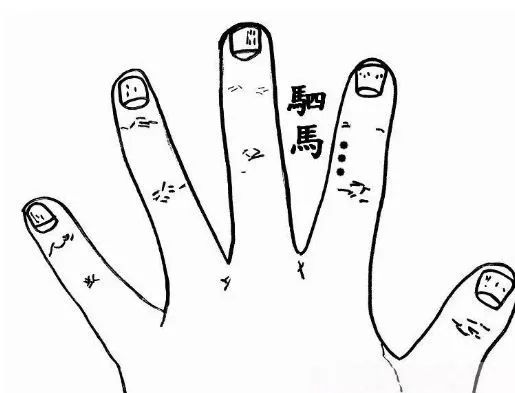
Finger Si Ma Point
Location: Si Ma Er point—on the back of the hand, three-tenths of an inch from the center of the second phalanx of the index finger.
Si Ma Yi point—two and a half tenths below Si Ma Er point.
Si Ma San point—two and a half tenths above Si Ma Er point.
Anatomy: Contains the median nerve superficial branches and lung branch nerves.
Needling: Same as the acupoint.
Meridian: Enters the Lung Meridian.
Point Characteristics: Dispels wind and releases the exterior, harmonizes qi and blood.
Indications: Skin diseases, facial blemishes, freckles, rhinitis, tinnitus, otitis media, chest pain, pleurisy.
Needling Technique: Straight insertion of one to two tenths.
Needle Sensation: Localized soreness and distension.
Note: The finger Si Ma point is on the same line as the finger Wu Jin and finger Qian Jin points. The finger Wu Jin is on the first phalanx of the index finger, while the finger Si Ma is on the second phalanx. Dong Gong’s original text states to open two tenths, while Hu’s text states three tenths, which accounts for the difference.
Experience: The Si Ma point has both hand and foot Si Ma points, both of which enter the Lung Meridian and are the main points for regulating qi, primarily treating skin-related issues. They are effective for various skin diseases, acne, and blemishes.
Paired Points:
(1) For treating blemishes, the Si Ma point can be paired with the San Huang point, Tong Guan, and Tong Shan for better results.
(2) For treating red, swollen, large acne, this point can be paired with the San Zhong point.
Bone-Reducing Needle and San Huang for various bone spurs.
6. Tong Guan, Tong Shan, Tong Tian combined with Bloodletting Needle Technique for Treating Viral Myocarditis.
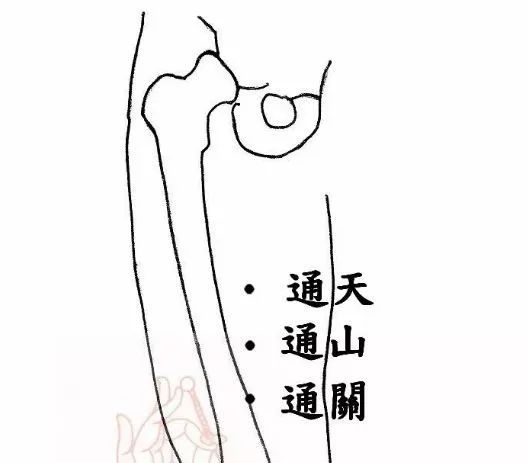
Tong Guan Point: Located on the midline of the thigh, five inches above the knee crease.
Tong Shan Point: Located two inches above the Tong Guan point on the midline of the thigh.
Tong Tian Point: Located four inches above the Tong Guan point on the midline of the thigh.
Indications: Heart disease, pericarditis (pain in the heart area), pain on both sides of the heart, rheumatic diseases originating from the heart, dizziness, blurred vision, palpitations, stomach diseases, limb pain, cerebral anemia.
Needling Technique: Needle depth of five tenths to one inch and five tenths. Tong Guan, Tong Tian, and Tong Shan points are usually needled one to two points. For patients with high blood pressure, only one point should be needled on each foot.

Internal Tong Guan Point: Open five tenths inward from the Tong Guan point.
Internal Tong Shan Point: Open five tenths inward from the Tong Shan point.
Internal Tong Tian Point: Open five tenths inward from the Tong Tian point.
Indications: Hemiplegia, limb weakness, limb nerve paralysis, heart failure, stroke with speech impairment, back pain and weakness caused by heart dysfunction, limb weakness.
Needling Technique: Needle depth of five tenths to one inch. Internal Tong Guan, Internal Tong Shan, and Internal Tong Tian are used together, forming a straight three-needle technique.
7. Xia San Huang for Diabetes.
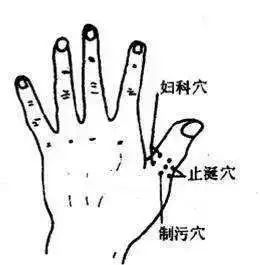
Tian Huang Point
Location: Bend the knee, one inch below the inner condyle of the tibia. This is one inch below the Yin Ling Quan point of the fourteen meridians.
Meridian Anatomy: Lies over the nerves, renal nerves, six fu organ nerves, and branches of the heart nerve.
Needling: Located one inch below the inner condyle of the tibia, which is one inch below the Yin Ling Quan point of the fourteen meridians.
Meridian: Enters the Heart and Kidney Meridians.
Indications: Excessive stomach acid, regurgitation (reflux), nephritis, diabetes, protein in urine, cystitis.
Needling Technique: Straight insertion of five tenths to one inch and five tenths.
Needle Sensation: Sensation of soreness, distension, and electric sensation.
Note: Pregnant women should not be needled. Moxibustion is also not recommended.
Identification: The correct location of the Tian Huang point is one inch below the Yin Ling Quan point of the fourteen meridians, not the Yin Ling Quan point itself. Do not confuse them to avoid affecting the results, as the indications for Yin Ling Quan and Tian Huang differ. Readers should compare them themselves.
Application: This point can be paired with the Tian Huang auxiliary point to treat regurgitation and excessive stomach acid.
Experience: This point has reaction points on both sides of the neck near the supraclavicular fossa. Using pressure techniques can relieve pain in the neck area.
Paired Points:
(1) For neck sprain pain, this point can be paired with the Wan Shun San point (near Hou Xi), combined with guiding qi needle techniques, generally yielding immediate effects. If the effect is not apparent, bloodletting can be performed at the pain point.
(2) For shoulder pain, this point or the Kidney Gate point can be paired with the Jian Ning point (located between the San Jian and the middle of the San Jian), and if bloodletting is performed at the pain point, the effect is particularly good.
Ren Huang Point
Location: On the inner side of the tibia, three and a half inches above the inner ankle bone. This is five tenths above the San Yin Jiao point of the fourteen meridians.
Anatomy: Lies over the nerves, renal branch nerves, and lung branch nerves.
Needling: Located three and a half inches above the inner ankle bone, which is five tenths above the San Yin Jiao point of the fourteen meridians.
Meridian: Enters the Lung and Kidney Meridians.
Point Characteristics: Harmonizes blood, relaxes tendons, supplements kidney essence.
Indications: Gonorrhea, impotence, premature ejaculation, nocturnal emissions, lumbar spine pain, neck pain, dizziness, hand numbness, diabetes, hematuria (blood in urine), pyelonephritis, kidney deficiency-related back pain.
Needling Technique: Straight insertion of six tenths to one inch and five tenths.
Needle Sensation: Sensation of soreness, distension, and electric sensation.
Application: This point has a strong effect on enhancing essence and strength. It can be used as an anesthetic point during gallbladder and spleen surgeries.
Note: This point promotes uterine contractions, so pregnant women should not be needled.
The location of this point is five tenths above the San Yin Jiao point, do not confuse them. The San Yin Jiao point treats gynecological issues, while the Ren Huang point enters the kidney.
Experience:
(1) The Xia San Huang point combined with the San Cha Yi point and the Wu Xing point for bloodletting can enhance vision. Additionally, bloodletting at the Wu Xing point can treat symptoms like seeing floaters.
(2) Cosmetic acupuncture, combining the San Huang point with the Xia San Huang, Si Ma point, and Ling Gu point, has significant effects on facial beauty.
(3) The Xia San Huang point is often needled together in a straight style, regulating the entire body and the three burners, and can be used for maintenance and health care.
Di Huang Point
Location: Four inches above the Ren Huang point. This is seven and a half inches above the inner ankle bone.
Anatomy: Lies over the nerves, medial sural cutaneous nerve, and renal nerves.
Needling: Located seven and a half inches above the inner ankle bone, which is four inches above the Ren Huang point.
Meridian: Enters the Liver and Kidney Meridians.
Point Characteristics: Soothes the liver, relieves depression, supplements kidney qi.
Indications: Nephritis, limb edema, diabetes, gonorrhea, impotence, premature ejaculation, nocturnal emissions, proteinuria, hematuria, uterine tumors, irregular menstruation, kidney deficiency-related back pain.
Needling Technique: Straight insertion of one to two inches.
Application: The Tian Huang, Di Huang, and Ren Huang points are collectively known as the Xia San Huang. Sometimes, the Tian Huang, Di Huang, and Ren Huang points are also referred to as the Xia San Huang, paired with Tong Kidney, Tong Back, for treating kidney deficiency, nephritis, and diabetes.
Note:
(1) The Xia San Huang or Tong Kidney, Tong Back, and Tong Stomach point groups can be needled together, and combined with moxibustion at Zhong Wan, Guan Yuan, Shen Shu, Pi Shu, and Zu San Li for long-term treatment of diabetes, yielding good results.
(2) The Xia San Huang is a well-known key point for strengthening and supplementing the kidney in Dong’s acupuncture. Long-term needling combined with the San Huang can regulate and supplement the original qi, enhancing physical constitution. When enhancing physical constitution, do not needle for too long.
(3) The Xia San Huang combined with the San Huang, and Tong Guan, Tong Shan, Tong Tian, taking two points, occasionally needling Dong’s Tian Ying point on the back, and sometimes performing bloodletting at the correct point, can treat epilepsy. The author has several cases of successful cures, with a treatment period of three months.
8. Zhi Wu Point for Chronic Ulcers That Do Not Heal

Location: The center of the back of the thumb, three points in total.
Indications: Chronic ulcers, malignant tumors after surgery that bleed continuously and do not heal.
Needling Technique: Use a three-edged needle to draw out black blood for immediate effect.
9. San Cha Point Combined with Zu San Zhong for Treating Deafness.
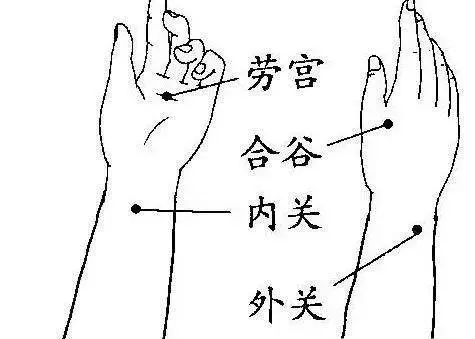
San Cha Yi Point
Location: At the center point of the fork between the index and middle fingers.
Anatomy: Contains the radial nerve superficial branch, lung branch nerve, and renal branch nerve.
Needling: Located at the center point of the fork between the index and middle fingers.
Meridian: Enters the Kidney Meridian.
Indications: Keratitis, eye soreness, lumbar pain, sciatica, brow pain, distension, optic nerve atrophy, hemiplegia, atrophy.
Needling Technique: Straight insertion of two inches. Insert the needle from the fork to the space between the two metacarpal bones. After making a fist, insert the needle from the fork.
Needle Sensation: Sensation of soreness, distension, and electric sensation.
Distinction: Although Dong’s San Cha point is the same as the eight evil points of the extraordinary points, the symptoms treated and the needling methods are completely different. The eight evils require needling three to five tenths or using a three-edged needle for bloodletting. In contrast, Dong’s San Cha point requires straight insertion of two inches, which is different from the eight evils. Readers are encouraged to distinguish carefully.
Note: The San Cha Yi, San Cha Er, and San Cha San points are not listed in Dong Gong’s writings but were included by Master Hu in his compilation of Dong’s extraordinary acupuncture points. The San Cha points are key points with remarkable effects passed down from Dong Gong. There are three San Cha points, each with different meridian affiliations, and they have the function of adjusting and supplementing the qi, making them frequently used key points by Dong Gong.
San Cha Er Point
Location: At the center point of the fork between the middle and ring fingers.
Anatomy: Contains the ulnar nerve dorsal branch, spleen nerve, and liver branch nerve.
Needling: Located at the center point of the fork between the middle and ring fingers.
Meridian: Enters the Spleen and Liver Meridians.
Point Characteristics: Strengthens the spleen, activates the collaterals, and promotes blood circulation.
Indications: Pancreatitis, splenomegaly, hemiplegia, sciatica, numbness of hands and feet, liver weakness.
Needling Technique: Straight insertion of two inches. Insert the needle from the fork to the upper edge of the metacarpal bone. After making a fist, insert the needle from the fork.
Needle Sensation: Sensation of soreness, distension, and electric sensation.
Distinction: Although this point is located at the same position as the eight evils (extraordinary points), the symptoms treated and the needling methods are different. Please pay attention to the distinction.
Experience:
(1) The San Cha Yi, San Cha Er, and San Cha San points, when needled together, greatly assist in restoring physical strength during colds. The San Cha points, like Dong’s extraordinary points such as Shen Er and Shui Jin, have the function of supplementing points, providing not only therapeutic effects but also the ability to regulate qi and blood. Individuals with a weak constitution can benefit from needling the Shen Er and San Cha points.
(2) Each San Cha point has its own meridian affiliation, and when used clinically, it is best to combine them with appropriate meridian points for better results.
San Cha San Point
Location: At the center point of the fork between the ring and little fingers.
Anatomy: Contains the ulnar nerve dorsal branch and renal nerve.
Needling: Located at the center point of the fork between the ring and little fingers.
Meridian: Enters the Kidney Meridian.
Point Characteristics: Nourishes the kidney, relieves pain, and promotes diuresis.
Indications: Dizziness, sciatica, long bone spurs, lumbar pain, kidney inflammation, kidney disease edema, severe colds.
Needling Technique: Straight insertion of two inches. Insert the needle from the fork to the upper edge of the metacarpal bone. After making a fist, insert the needle from the fork.
Needle Sensation: Sensation of soreness, distension, and electric sensation.
Distinction: Although this point is located at the same position as the eight evils (extraordinary points), the symptoms treated and the needling methods are completely different.
Experience:
(1) The San Cha San point enters the Kidney Meridian, thus in the five elements, it belongs to water. Individuals with reduced vision often have kidney water deficiency, as the liver is wood and governs the eyes. Therefore, nourishing the kidney can benefit the liver and improve vision significantly.
(2) After needling the San Cha San point, it can also be paired with the Wan Shun point to form Dong’s T-shaped needling technique, further enhancing the effect.
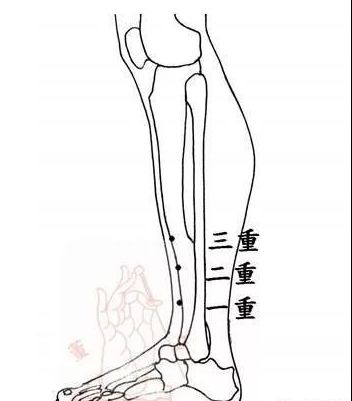
San Zhong Point
Location: Two inches above the Er Zhong point.
Anatomy: Contains the lateral sural cutaneous nerve, heart branch nerve, and lung branch nerve.
Needling: Located two inches above the Er Zhong point.
Meridian: Enters the Heart, Liver, Spleen, and Lung Meridians.
Point Characteristics: Breaks qi, promotes blood circulation, and eliminates stagnation.
Indications: Same as the Er Zhong point.
Needling Technique: Straight insertion of one to two inches. Use a three-edged needle for bloodletting.
Needle Sensation: Sensation of soreness, distension, and electric sensation.
Note: Needling the Yi Zhong, Er Zhong, and San Zhong points simultaneously forms a straight needle technique, which has the function of promoting qi, breaking blood, and calming the spirit. Especially when combined with needling techniques, it can accelerate the therapeutic effect.
Experience:
(1) The gynecological points and San Zhong point can be combined with Tian Ying needle techniques to treat uterine fibroids.
(2) The Jian Zhong, Jian Zhong, Fen Zhi Shang, and San Zhong points can treat breast tumors.
(3) The San Zhong point, combined with the Di Zong point and Mu Liu point, can treat tongue stiffness and speech difficulties, as the San Zhong point has a strong effect on the brain, improving brain cells.
(4) For lack of concentration and memory decline, needling the San Zhong point can be beneficial.
(5) Bloodletting at the San Zhong point can treat large neck lumps and prostate enlargement (requires pairing with the Zhi Da Jian, Wai Jian, and Jie Mei points).
10. Ce San Li and Ce Xia San Li for Treating Trigeminal Neuralgia with Remarkable Effects, Proven Time and Again
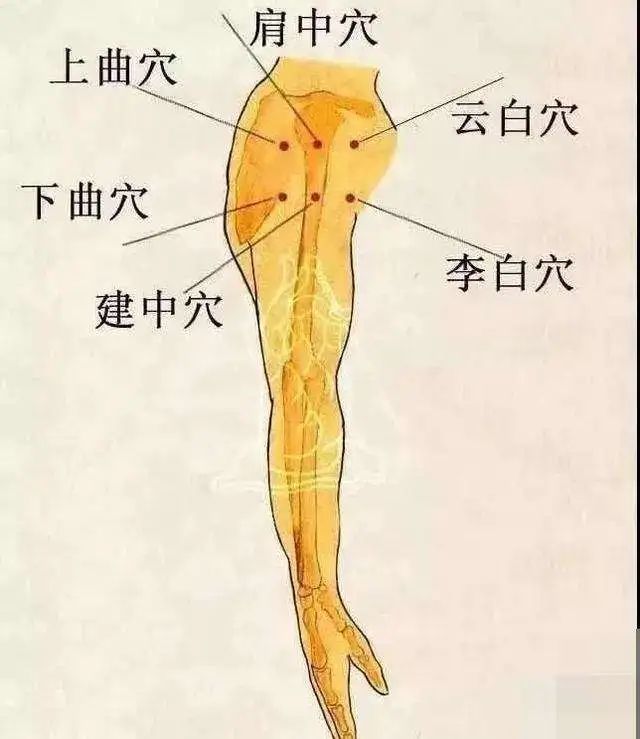
Location: Ce San Li point is located two and a half inches outward from the Si Hua Shang point, which is one and a half inches outside the foot San Li point of the fourteen meridians.
Anatomy: Contains the lateral sural cutaneous nerve, dental nerve, and lung branch nerve.
Needling: Located at the anterior edge of the fibula, two and a half inches outward from the Si Hua Shang point.
Meridian: Enters the Heart and Lung Meridians.
Point Characteristics: Invigorates blood, dispels stasis, reduces inflammation, and relieves pain.
Indications: Toothache, facial nerve pain, trigeminal neuralgia, intercostal neuralgia, appendicitis pain.
Needling Technique: Straight insertion of one to one and a half inches.
Needle Sensation: Sensation of soreness, distension, and electric sensation.
Experience: This point, along with the Wai San Guan and San Zhong points, can be referred to as the lateral lung area of the foot. If there are any discolorations or abnormalities in this area, bloodletting can be performed to treat head and facial diseases, as well as lung and chest-related conditions.
Note: This point is effective for treating migraines, thyroid enlargement, and sublingual swelling, similar to the effects of the San Zhong point. It can be alternated with the Si Ma point for good results.
Paired Points:
(1) Needling this point can be paired with the Si Hua point for bloodletting, which is effective for treating toothaches.
(2) This point can be paired with Ling Gu and Xin Men points for effective treatment of fullness.
(3) This point can be paired with the San Zhong point to treat parotitis, and bloodletting can also be performed at the pain point.
Follow the Guoxue Sui public account for more content.
|
I Copyright Statement:○Content and images in this article are sourced and compiled from the internet.。○ Copyright belongs to the relevant rights holders. If there are any improper uses, please contact us for immediate deletion.I Submission Email:[email protected] I Warning:This platform’s articles are for the purpose of popularizing TCM knowledge and are for reference and learning by professional TCM practitioners only. They do not serve as prescriptions and do not constitute any advice, recommendations, or guidance. Please do not blindly try medications; this platform does not bear any responsibility for any consequences arising from this. If needed, please use under the guidance of a physician. All articles published on this platform only represent the author’s views. |
Recommended Reading
【Guoxue Sui】Selected exquisite articles from the public account:① Traditional Chinese Painting: A Brushstroke Guide to Painting the Impressionistic “Cockscomb Flower and Beetle”② From Reproductive Love to Immortal Romance, the Mysteries of Bedroom Techniques—Exploring the Principles of “Fengshen Yanyi” (Part Two)③ Zhu You’s Technique: The Secret of Soul Retrieval【Knowledge and Learning】Selected exquisite articles from the public account:① The Qin Dynasty had the “Four Great Legions” to unify China; what was the ultimate fate of the legion that swept through the six directions?② This woman had “the talent of Lü Bu but lacked Lü Bu’s evil”; her life was quite legendary as she listened to the curtain and governed.③ Chiang Kai-shek’s slap created an image of a “just and fair” figure, but why did he not dare to strike? 【Qi Huang Folk Inheritance】Selected exquisite articles from the public account:① The miraculous folk method of moving sores and diseases, transferring serious sores and tumors from important areas to secondary areas—clinical applications of the moving sore method.② Difficulty falling asleep, dreaming too much, waking up easily, waking up at set times, and insomnia—Professor Xu Hao’s experience in diagnosing and treating insomnia.③ The Lin family has over a hundred years of experience in treating bones: Lin Ru Gao’s treatment of fractures in 188 cases with bone-repairing pills. ④ Irregular sexual life leading to premature ejaculation—Professor Li Yueqing’s clinical experience in treating male diseases combined with anxiety and depression. ⑤ Introducing an ancient secret recipe—Da Cheng Dan Fang. ⑥ Treatment of gastric cancer, intestinal cancer, esophageal cancer, and other digestive tract tumors and other malignant tumors with the Xia Tan San Jie Fang. ⑦ Self-formulated Zhen Xiong Decoction for treating impotence in 76 cases, balancing yin and yang, addressing both deficiency and excess, a wonderful remedy for simultaneous tonification and supplementation. ⑧ Treatment of infertility, impotence, premature ejaculation, lumbar and knee soreness, fatigue, and other conditions with the Yi Jing Zhuan Zhi Decoction—Professor Wang Jinsong’s clinical insights. More exciting and excellent content can be found in historical articles.

